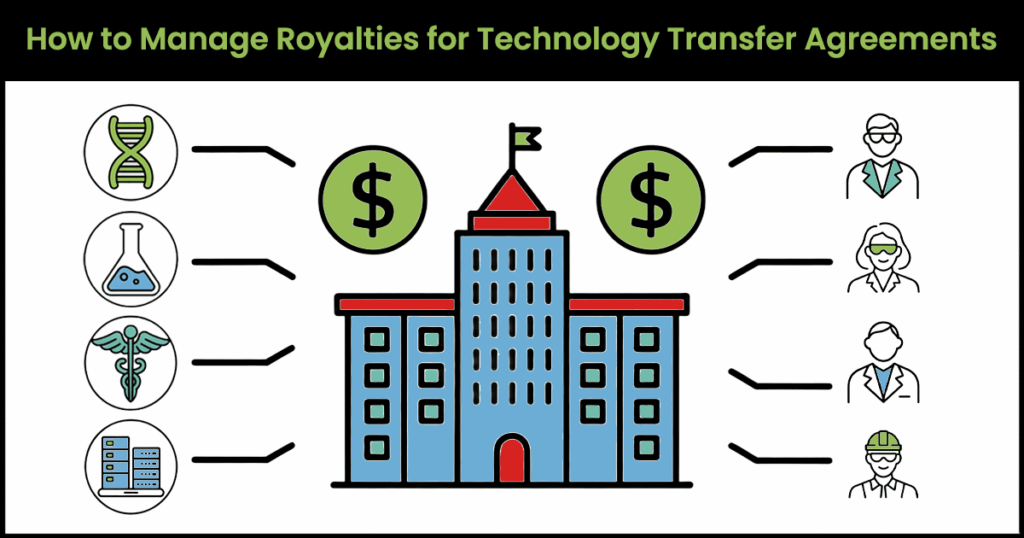No Results Found
The page you requested could not be found. Try refining your search, or use the navigation above to locate the post.
The page you requested could not be found. Try refining your search, or use the navigation above to locate the post.
If you’re involved in licensing technology from a university, research institution, or federal lab—or granting those rights to others—managing royalties is one of the most critical (and complex) parts of the process. In this blog post, you’ll learn exactly how royalties work in technology transfer agreements, what responsibilities fall on both licensors and licensees, and how to stay compliant while minimizing administrative headaches. In short, you need a clear understanding of the agreement terms, airtight recordkeeping, and the right tools to stay organized.
Organizations managing technology transfer agreements find that MetaComet’s automation tools eliminate the administrative headaches while maintaining compliance and accurate recordkeeping.

The term “technology transfer agreement” (or TTA) most commonly refers to a legal contract that outlines the terms under which one party (often a research institution, university, or company) grants another party (or licensee) the right to use, develop, or commercialize a specific technology. The primary purpose of a technology transfer agreement is to facilitate the legal and practical transfer of intellectual property (IP) from one entity to another.
Specific purposes of the agreement include:
Various types of agreements enter into the tech transfer process.
Multiple agreement types, diverse IP licensing, complex revenue distributions, various stakeholders – why struggle with these technology transfer agreement complexities when our automation tools handle everything? Save 90% of your revenue distribution management workload. Find out how: talk to our team of royalty experts today.
The licensed materials in a technology transfer agreement are often, but not necessarily, scientific or technological inventions. They may or may not be copyrightable material, patents, or trademarks. The two things they all have in common is that they are newly created and have some sort of commercial value.
Some types of IP that are often licensed in tech transfer agreements include:
A tech transfer license agreement will define the fees and royalties to be paid to the licensor. In turn, that institution, depending on its own policies and agreements, will pay out distributions to various parties that enabled the research, possibly including:

Royalties play a central role in many technology transfer agreements as a way for the licensee to compensate the licensor. The licensee will make periodic payments to the licensor based on a percentage of sales, a fixed amount per unit sold, or usage rates. Royalty-related clauses in a TTA will typically include:
To effectively manage royalties and distributions arising from technology transfer agreements, a licensor’s technology transfer office (TTO) needs to have a strong grasp of both the financial and administrative aspects of royalty management, while ensuring compliance with institutional policies, legal requirements, and stakeholder expectations. Specifically, the TTO must:
Like the licensor receiving the royalty payments, the licensee making the payments needs to have a clear record and understanding of the agreement terms, in particular:
Whether you’re a TTO or a licensee, MetaComet® can automate the calculation, payment, and tracking of all your payments related to technology transfer agreements.
Whichever side of the tech transfer agreement you’re on, MetaComet can save you time, minimize risks, and eliminate the stress around technology transfer payments. Contact us to discuss your needs and find out how MetaComet can work for you.

David Marlin is the President and Co-Founder of MetaComet® Systems, a prominent provider of royalty automation tools. Since founding the company in 2000, David has spearheaded the development of a suite of best-in-class systems that effectively facilitate royalty processes for nearly 200 publishers. David has also served as the chair for The Book Industry Study Group’s Rights Committee and Digital Sales Committee.
Before establishing MetaComet Systems, David served as a technology consultant for renowned publishers, collaborating with notable companies such as Random House, Penguin, HarperCollins, Holtzbrinck, Macmillan, Scholastic, Time Warner, and many others. David holds both an MBA and a BA from Columbia University in New York.
"*" indicates required fields